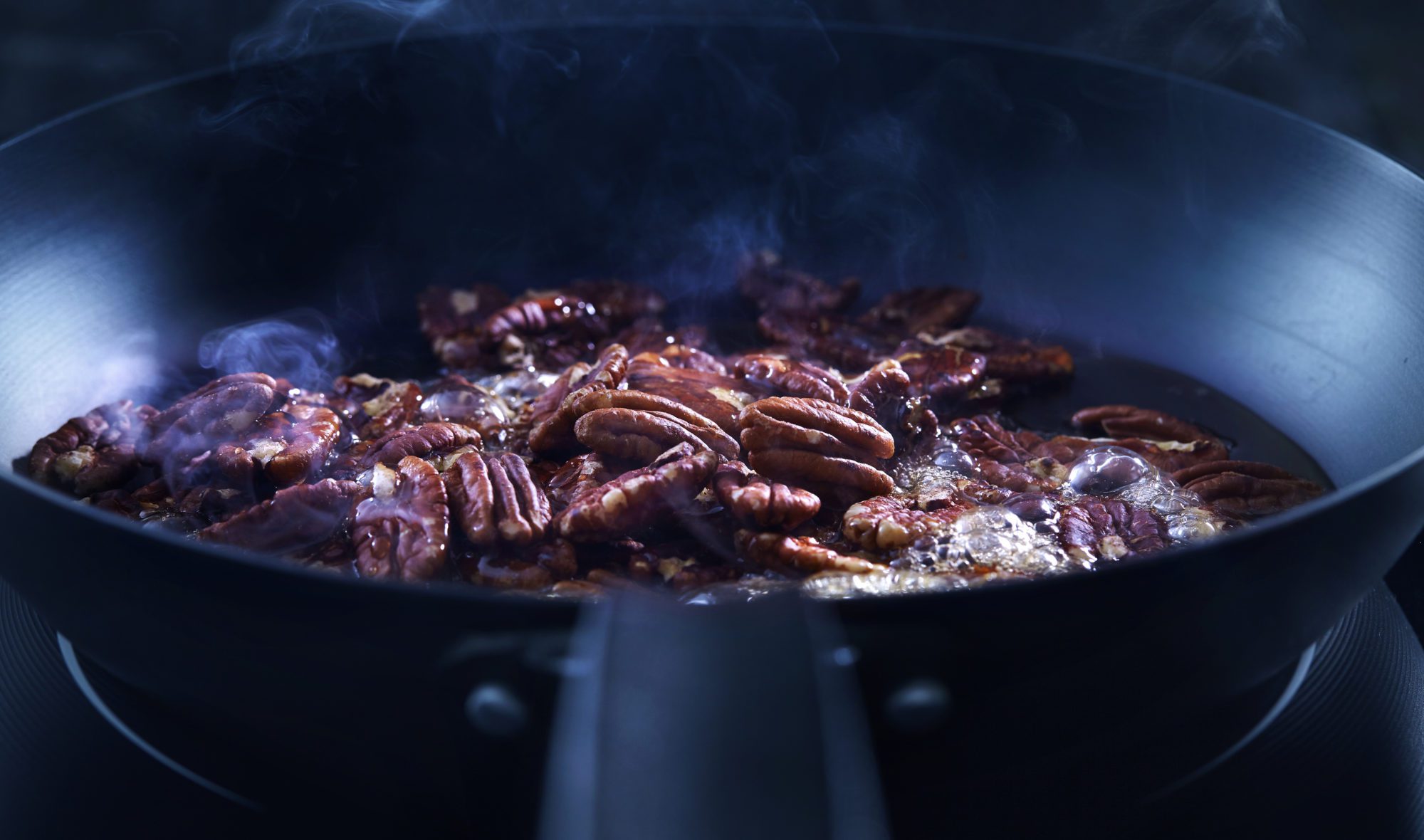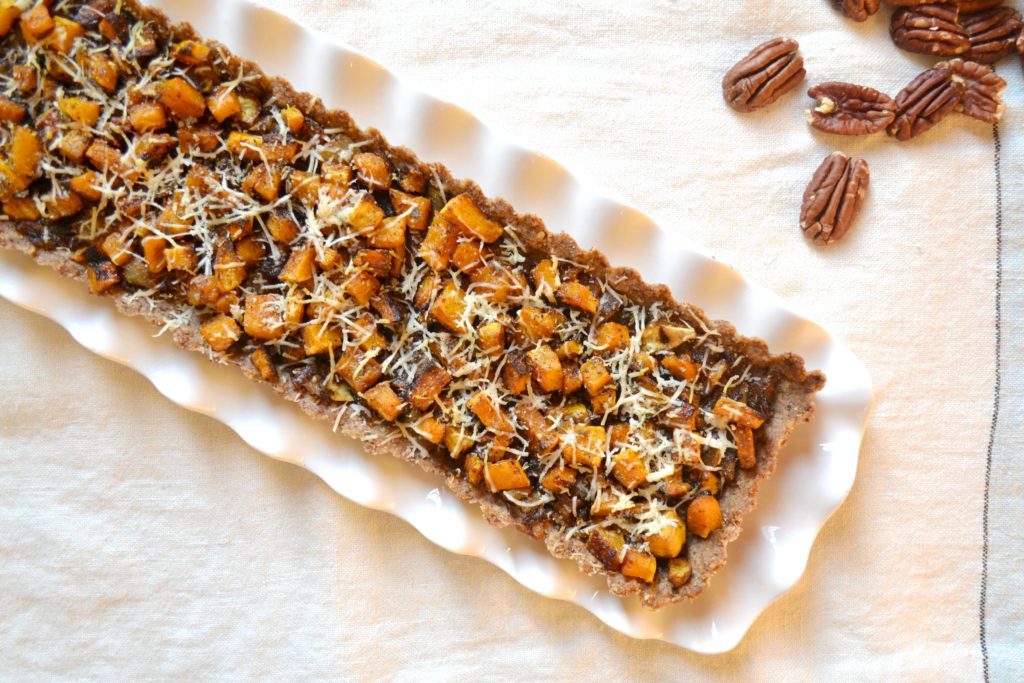Pecans


Pecans, however you pronounce them (PEE-can? Puh-KAHN?), are the delicious seeds of a husky green fruit. Pecans are deeply rooted, both in the history and the literal soil of the American South, where they have been an important commercial crop for centuries. Pecans come, in twins, in oval, glossy brown shells. The nuts themselves are lobed and wrinkled, much like a walnut. Pecans have a high oil content and therefore are delightfully rich and buttery tasting, with a hint of sweetness. Pecans are an excellent source of manganese, and a good source of vitamin B1 (thiamine), zinc, phosphorus, and magnesium. For the freshest and most flavorful pecan experience, try to find them still in their shell, which can be cracked open using a nutcracker or, if you’re (very) old-school, a rock.
Pecans are technically not nuts but rather the seed of a husky green stone fruit, which splits open when the fruit is ripe. Pecans grow on beautiful trees which can live up to 1,000 years, whose branches can stretch up to 180 feet.
Although there is evidence of pecan trees growing wildly in various parts of Europe, Asia, and North America in the past million years, they grow particularly well in the American South, and it is in this region where pecans first became a major industry.
It is said that the Native Americans in Mexico and the US were among the first to cultivate pecans, but by the late 1700’s American colonists realized the economic potential of this delicious nut and began to more aggressively expand pecan cultivation for the purpose of commercialization.
Although harvesting techniques have changed (there are now machines to shake the nuts off their branches, and to scoop them off the ground), most commercial pecan cultivation still occurs in the same region of the US where the pecan industry was born: Texas, Mississippi, Louisiana, New Mexico, Georgia, and Florida.
The pecan tree is the official state tree of Texas, where, even there, no one can agree on whether it’s pronounced PEE-can or puh-KAHN.
Pecans may be found either still in the shell, or out of it.
In their shell, pecans nestle in twos covered by a smooth, oval, reddish-brown shell. The shell is woody and hard and must be cracked with a tool (like a nutcracker) in order to be opened.
Pecans themselves are lobed and wrinkled like walnuts, except the grooves that mark the pecan are shallower and more linear than those of the walnut. The flesh of the pecan is whitish and covered by a thin brown skin, and possesses a gentle crunch.
The flavor of pecans is buttery, nutty, and slightly sweet, with hints of maple.
One ounce of pecans (about 19 halves) has 196 calories, 2.6g of protein, 20.4g of fat, 3.9g of carbohydrates, 2.7g of fiber, and 1.1g of sugar. Pecans are an excellent source of manganese, and a good source of vitamin B1 (thiamine), zinc, phosphorus, and magnesium.
Pecans are widely available at most grocery stores, health food stores, and bulk food stores.
Like most nuts, pecans have a very high-fat content and therefore are vulnerable to rancidity. In order to ensure freshness, shop at stores with high turnover and, if you can find them and are willing to go through the effort of cracking them, choose pecans that are still in their shell. They will likely be the freshest and most flavorful options.
If they are still in their shell, look for nuts that are heavy for their size and do not rattle when shaken. The shells should be free of stains, cracks, or holes.
If the pecans are out of their shell, choose nuts that look plump and even in color and size. Discard any that are stained or shriveled, or that taste or smell bitter.
Pecans, due to their high oil content, are prone to rancidity and are best kept in the fridge or freezer. Out of their shell, they will keep for up to six months in the fridge or up to one year in the freezer.
Please note that pecans also readily absorb odors so should be kept in an airtight container, away from, say, your batch of homemade garlic sauerkraut.
Pecans, once they are out of their shell, are ready to be eaten.
They are delicious on their own as a snack, but they also work well in many a dish, be it sweet or savory: Top pecans over grain pilafs, cooked breakfast cereals, salads, stir-frys; bake into muffins; or crust over baked fish or poultry.

Perhaps not an everyday dish, this elegant tart is more of a special occasion show-stopper. Toasty pecans and dates combine to make a rich crust, which is topped with caramelized onions, butternut squash, and a sprinkling of parmesan cheese.
Prep Time: 30 minutes Cook Time: 65 minutes Yield: 6-8 servings
For the crust:
Place pecans in a food processor and pulse until a coarse, gravely texture is achieved. Add chopped dates, eggs, and sea salt and pulse again until uniform, mealy texture is achieved.
Grease tart or pie pan* with butter and using clean hands, press pecan “dough” into the pan, trying to ensure even crust depth across the pie.
Place the pan in a preheated 350 degree Fahrenheit oven, and bake for 10-15 minutes.* Remove from the oven and allow to cool slightly before filling.
*Recipe makes a thick crust for a 4” x 14” rectangular tart pan or a thin crust for a standard 9” pie pan. Adjust cooking times according to thickness.
For the filling:
Add sliced onions, butter, and salt to a pan over medium heat, stirring frequently (every few minutes) to prevent scorching. Cook until caramelized, about 40 minutes.
While onions are caramelizing, prepare the squash: Pour melted butter over cubed butternut squash, sprinkle with salt, and stir to coat. Spread out over parchment paper-lined baking tray, and place in preheated 400 degree Fahrenheit oven. Bake for 20 minutes, remove the tray from oven and shuffle cubes around with a spatula for even browning. Place bake in the oven and bake for another 15 minutes.
When both the onions and the squash are done, fill your pie crust: First, layer caramelized onions on the bottom in an even layer. Then, add the butternut squash, arranging cubes in an even layer. Sprinkle dried sage, nutmeg, and freshly cracked pepper over top, and then cover with parmesan cheese.
Set the oven to broil, and place the pan in the oven for 3-5 minutes, watching the parmesan closely so it doesn’t burn. When it’s done, remove from the oven, and allow the tart to cool before serving. This makes a wonderful meal served alongside a simple green salad or some steamed greens.
Precision Nutrition’s Encyclopedia of Food expands every single month as we highlight new foods and showcase beautiful food photography. If you’d like to stay up to date, simply click this link. From there, we’ll send you a FREE copy of our recipe book. We’ll also let you know when new and delicious foods are added to the site.
Pecans, however you pronounce them (PEE-can? Puh-KAHN?), are the delicious seeds of a husky green fruit. Pecans are deeply rooted, both in the history and the literal soil of the American South, where they have been an important commercial crop for centuries. Pecans come, in twins, in oval, glossy brown shells. The nuts themselves are lobed and wrinkled, much like a walnut. Pecans have a high oil content and therefore are delightfully rich and buttery tasting, with a hint of sweetness. Pecans are an excellent source of manganese, and a good source of vitamin B1 (thiamine), zinc, phosphorus, and magnesium. For the freshest and most flavorful pecan experience, try to find them still in their shell, which can be cracked open using a nutcracker or, if you’re (very) old-school, a rock.